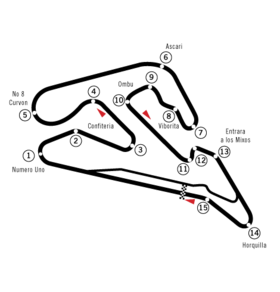Argentine Grand Prix

| |
| Argentine Grand Prix | |
|---|---|
| Flag | |
| Circuit | Buenos Aires Circuit |
| Circuit image | |
| Laps | 72 |
| Circuit length km | 4.259 |
| Race length km | 306.648 |
| Circuit length mi | 2.646 |
| Race length mi | 190.542 |
| Most wins driver | |
| Most wins constructor | |
| Current year | 1998 |
| Winner | |
| Winning team | |
| Winning time | 1:48:36.175 |
| Pole driver | |
| Pole team | |
| Pole time | 1:25.852 |
| Fastest lap driver | |
| Fastest lap team | |
| Fastest lap | 1:28.179 |
The Argentine Grand Prix was a round of the Formula One championship, held intermittently from 1953 to 1998. Although it is no longer on the Formula One calendar, the race has a long and varied history. Argentine president Juan Perón was the driving force behind the creation of the circuit, after seeing the success of the country's own Juan Manuel Fangio.
Built just outside of Buenos Aires on swampland in 1952, the "Autódromo", as it was known, featured a white archway dedicated to the memory of Admiral Guillermo Brown (William Brown). The circuit opened in March 1952 with the running of the "Perón Cup", which was won by Fangio. In 1953, the Autodrome hosted the first ever Formula One race held outside Europe. The race saw native son Fangio retire his Maserati after 36 laps due to a transmission failure; Alberto Ascari's victory for Ferrari was tragically overshadowed by a stadium accident which killed nine people.
The following year, Fangio did reach the top step of the podium, winning his home Grand Prix on his second attempt; he would go on to win three of the next four Grands Prix in Argentina. In 1958, Stirling Moss took the win, in what would be the penultimate race in Fangio's distinguished career. With his retirement, and with the exile of Peron (in 1955) leading to several unstable governments, the Argentine Grand Prix disappeared from the F1 calendar in 1961 for over a decade.
A non-championship Formula One race was held at Buenos Aires in 1971, won by Chris Amon over two heats. In 1972 the Argentine Grand Prix returned to the World Championship, with Carlos Reutemann emerging as the new homegrown hero. Reutemann took pole position in his world championship debut, becoming only the second driver to achieve this feat. The race was won by world champion Jackie Stewart. The Grand Prix remained in Argentina through 1981, but the 1982 event was canceled.
A private consortium purchased the track in 1991 and began to upgrade it. They got on the 1994 F1 season calendar, but the race (set for October) was aborted to continue modernization. The modernized Argentine Grand Prix returned in 1995, with victory going to Damon Hill. Hill would win the event again in 1996 (his championship season), and in 1997 Jacques Villeneuve won the race in his championship season. Unfortunately, with the organizers of the event running into financial difficulties, the 1998 race was the last running of the Argentine Grand Prix, the checkered flag waving victory to Michael Schumacher, in his ninth win for Ferrari.
Winners
Multiple winners (drivers)
| Number of wins | Driver | Achieved |
|---|---|---|
| 4 | 1954, 1955, 1956, 1957 | |
| 2 | 1973, 1975 | |
| 1995, 1996 |
By Year
| Races in the Formula One championship: | |
|---|---|
| 2007 championship Grand Prix events: | |
|
Australian |
Malaysian |
Bahrain |
Spanish |
Monaco |
Canadian |
U.S. |
French |
British | |
| Past championship Grand Prix events: | |
|
Argentine |
Austrian |
Dutch |
Indy 500 |
Las Vegas |
Luxembourg |
Mexican |
Morocco | |
| Confirmed future Grand Prix events: | |